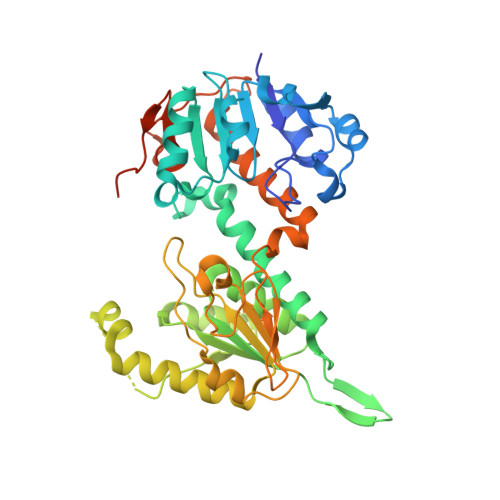X-ray Structure of Domain I of the Proton-pumping Membrane Protein Transhydrogenase from Escherichia coli
Johansson, T., Oswald, C., Pedersen, A., Tornroth, S., Okvist, M., Karlsson, B.G., Rydstrom, J., Krengel, U.(2005) J Mol Biol 352: 299-312
- PubMed: 16083909
- DOI: https://doi.org/10.1016/j.jmb.2005.07.022
- Primary Citation of Related Structures:
1X13, 1X14, 1X15 - PubMed Abstract:
The dimeric integral membrane protein nicotinamide nucleotide transhydrogenase is required for cellular regeneration of NADPH in mitochondria and prokaryotes, for detoxification and biosynthesis purposes. Under physiological conditions, transhydrogenase couples the reversible reduction of NADP+ by NADH to an inward proton translocation across the membrane. Here, we present crystal structures of the NAD(H)-binding domain I of transhydrogenase from Escherichia coli, in the absence as well as in the presence of oxidized and reduced substrate. The structures were determined at 1.9-2.0 A resolution. Overall, the structures are highly similar to the crystal structure of a previously published NAD(H)-binding domain, from Rhodospirillum rubrum transhydrogenase. However, this particular domain is unique, since it is covalently connected to the integral-membrane part of transhydrogenase. Comparative studies between the structures of the two species reveal extensively differing surface properties and point to the possible importance of a rigid peptide (PAPP) in the connecting linker for conformational coupling. Further, the kinetic analysis of a deletion mutant, from which the protruding beta-hairpin was removed, indicates that this structural element is important for catalytic activity, but not for domain I:domain III interaction or dimer formation. Taken together, these results have important implications for the enzyme mechanism of the large group of transhydrogenases, including mammalian enzymes, which contain a connecting linker between domains I and II.
Organizational Affiliation:
Department of Chemistry and Bioscience, Chalmers University of Technology, P.O. Box 462, SE-405 30 Göteborg, Sweden. tomas.johansson@chembio.chalmers.se















